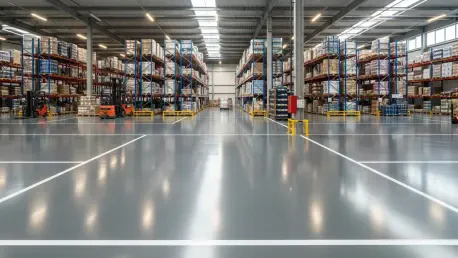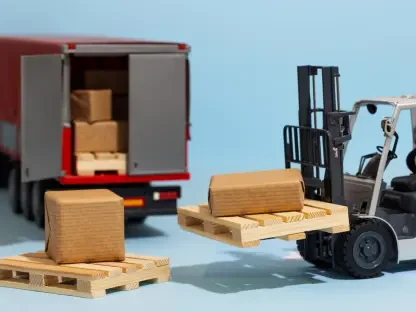Setting the Stage for Resin Flooring’s Market Surge
Imagine a world where industrial warehouses, cutting-edge retail spaces, and critical healthcare facilities all share a common foundation—a flooring solution that not only withstands punishing conditions but also elevates design and champions sustainability. This is the reality resin flooring brings to modern construction, a sector witnessing remarkable growth as demand for versatile, eco-friendly materials skyrockets. This market analysis delves into the driving forces behind resin flooring’s ascent, examining current trends, data-driven insights, and future projections. The purpose is to equip architects, specifiers, and property developers with a clear understanding of why this material is reshaping the built environment. By exploring performance metrics, environmental impacts, and industry standards, this discussion highlights the strategic importance of resin flooring in meeting today’s complex building needs.
Diving Deep into Market Dynamics and Forecasts
Current Trends Shaping the Resin Flooring Landscape
Resin flooring, encompassing systems like epoxy and polyurethane, has carved a significant niche across industrial, commercial, healthcare, and residential sectors. Market data indicates a robust compound annual growth rate (CAGR) in global demand, fueled by the material’s ability to endure high-traffic conditions while offering aesthetic versatility. In regions like the UK, industry bodies have reported a surge in adoption within commercial projects, driven by the need for durable yet visually appealing solutions in spaces such as retail showrooms and office complexes. This trend reflects a broader shift toward materials that balance functionality with design, positioning resin flooring as a top choice for specifiers aiming to meet diverse client expectations.
A notable pattern is the growing emphasis on customization. Manufacturers are increasingly offering tailored formulations to address specific requirements, such as chemical resistance for industrial plants or slip prevention in hospitals. This adaptability has broadened the material’s appeal, with applications expanding beyond traditional heavy-duty environments into more design-focused settings. The challenge lies in maintaining cost competitiveness while delivering bespoke solutions, a hurdle the industry is tackling through streamlined production processes and enhanced supply chain efficiencies.
Sustainability as a Market Driver
Sustainability has emerged as a pivotal factor propelling resin flooring’s market share, aligning with the construction industry’s push toward greener practices. Many modern resin systems now feature low-VOC formulations, minimizing harmful emissions and improving indoor air quality—a critical consideration for sensitive environments like schools and medical facilities. Additionally, the integration of recycled and bio-based materials is reducing embodied carbon, helping projects comply with stringent green building standards such as BREEAM and LEED. Market reports highlight that these eco-friendly attributes are not just a niche appeal but a core demand driver, especially in Europe and North America.
The long lifespan and minimal maintenance needs of resin flooring further enhance its environmental credentials. Unlike traditional materials that require frequent replacement, resin systems reduce waste and lifecycle costs, offering economic benefits alongside ecological ones. However, scaling these sustainable innovations remains a challenge, as upfront costs can deter smaller projects. Industry stakeholders are addressing this by investing in research to lower production expenses without compromising quality, ensuring broader market accessibility.
Future Projections and Technological Advancements
Looking ahead, the resin flooring market is poised for dynamic expansion, with projections estimating continued growth through 2025 to 2027, driven by technological advancements and regulatory shifts. Innovations in formulation are expected to yield even greener products, with a focus on bio-based resins and advanced recycling methods to further cut carbon footprints. Digital tools, such as 3D modeling for project planning, are also set to revolutionize installation precision, reducing material waste and project delays. These developments signal a market ready to embrace efficiency and sustainability as non-negotiable priorities.
Regulatory landscapes, particularly in the EU and UK, are likely to tighten environmental standards, pushing manufacturers toward greater transparency in sourcing and emissions reporting. Analysts anticipate that resin flooring will lead the charge in meeting these mandates, potentially integrating smart technologies like embedded sensors to monitor wear and tear in real time. Such advancements could redefine maintenance strategies, offering predictive insights that extend flooring lifespans. The market’s trajectory suggests a future where resin flooring not only meets functional demands but also pioneers innovation in the construction materials sector.
Reflecting on Insights and Strategic Pathways
This analysis of the resin flooring market reveals a compelling narrative of growth, driven by a unique blend of durability, design flexibility, and sustainability. It is evident that the material’s ability to cater to diverse sectors—from industrial to residential—positions it as a cornerstone of modern construction. The focus on eco-friendly formulations and compliance with green standards underscores a pivotal shift toward environmental responsibility, while technological forecasts hint at a transformative era ahead for the industry. For stakeholders, the strategic takeaway is clear: early collaboration among architects, manufacturers, and contractors proves essential to tailoring solutions that maximize performance and value. Moving forward, prioritizing lifecycle cost assessments over initial investments offers a path to long-term savings, while leveraging industry guidelines ensures compliance and quality. As the market continues to evolve, exploring emerging technologies and sustainable practices emerges as a critical next step for staying competitive in a rapidly changing landscape.









